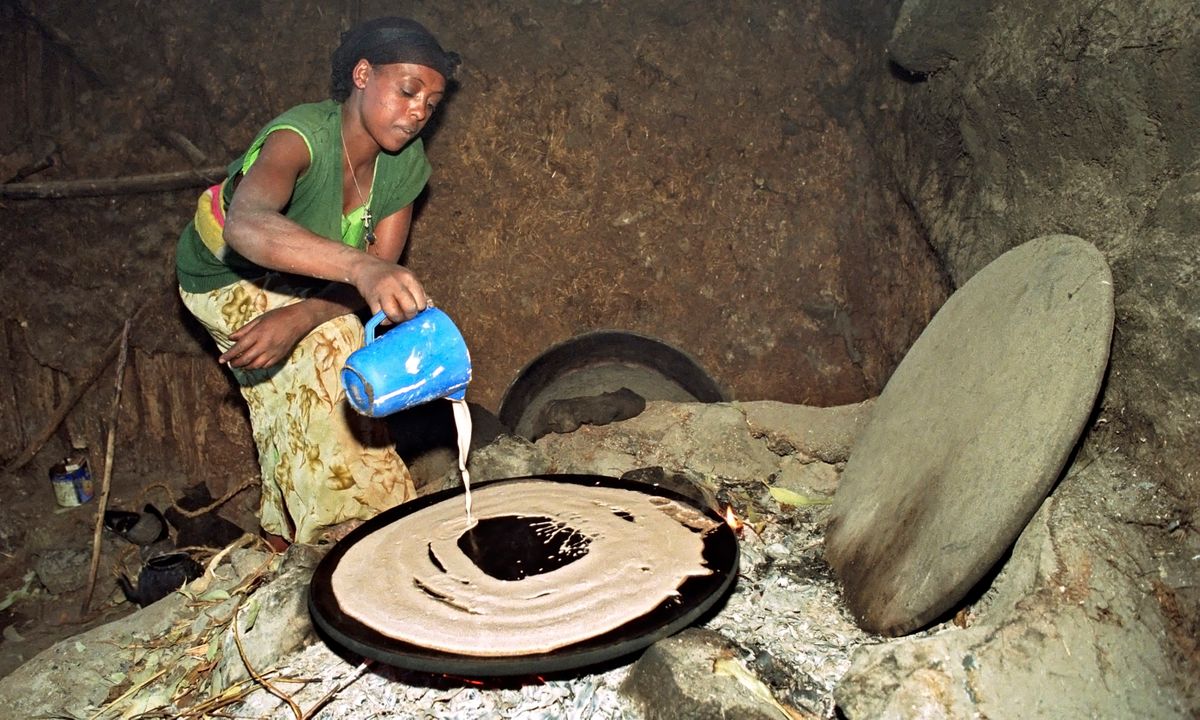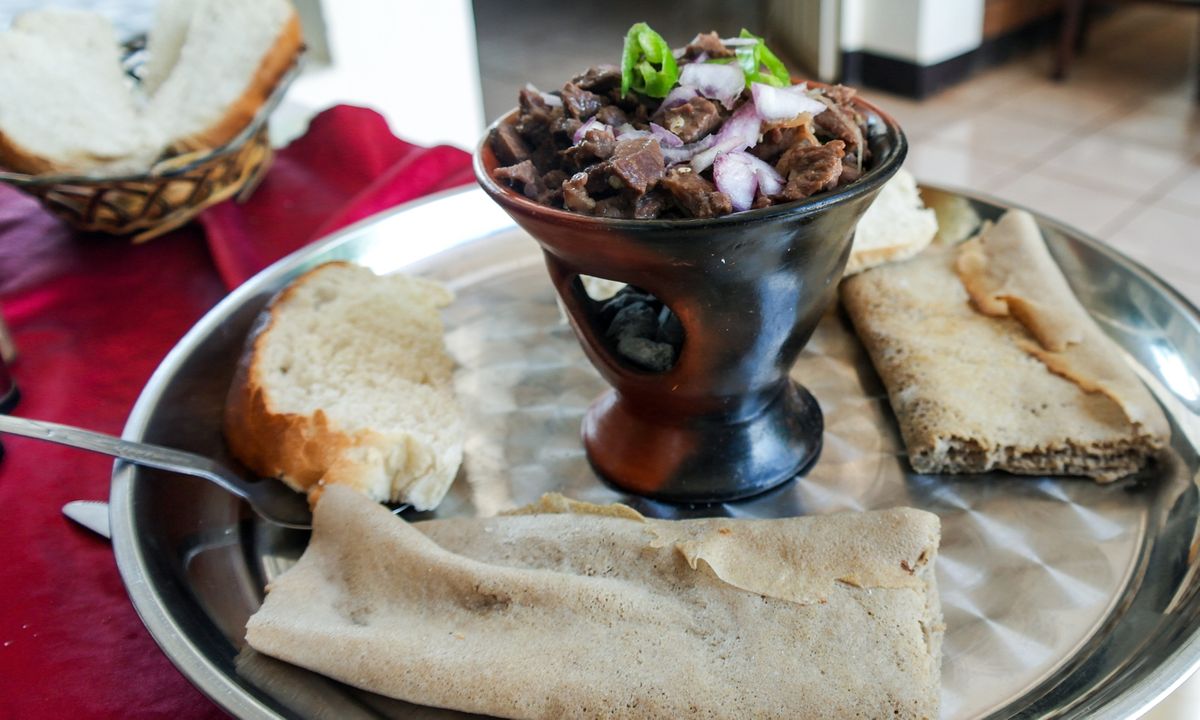After visiting Ethiopia to celebrate Timket, Lynn Houghton reveals the unique Ethiopian food and drink experiences you shouldn’t miss
1: An Ethiopian coffee ceremony

An Ethiopian coffee ceremony (Lynn Houghton)
There are conflicting reports as to who first discovered coffee beans in Ethiopia’s highlands. Around 850 A.D., a goat herder named Kaldi noticed his animals eating the bitter red berries and noticed it altered their behaviour; this was then reported to the local Monks who took to brewing this magic potion. However, it is also recorded that the Oromo tribe would chew coffee beans as a stimulus for hunting while a Moroccan Sufi mystic was also credited with being the first to try coffee while in Ethiopia.
Whatever the origin, Ethiopian people, and the world, have been enjoying this deep dark delicious drink for hundreds of years. The Ethiopian coffee ceremony involves getting neighbours over to share conversation and a beverage, but the ritual is performed in coffee houses, too. First, popcorn is made and set aside to accompany the coffee. Then fresh beans are roasted on a tiny fire with incense burning close by. Small china cups, without handles, are carefully laid out as the beans are roasting.
Once finished, the beans are then ground, mixed with water and returned to the fire in a metal coffee pot. An incredible smell wafts through the air as the coffee percolates. It is then carefully poured out, and enjoyed by everyone taking part. Milk is never added but sugar is usually available.
2: Injera Bread

Making injera on a wood fire (Dreamstime)
The Ethiopians, quite ingeniously, use injera, a type of flatbread, as an eating utensil. With their right hand, they scoop up curries, salads, lentils and meat with a torn off bit of the bread and then pop it in their mouths. Injera is made with Teff flour, cooked and then allowed to ferment for 3 – 4 days. The result, after baking, is a sour, spongy bread that looks a bit like a soft tortilla and has quite an unusual tangy flavour.
3: The Fasting Plate

A typical fasting plate (Lynn Houghton)
During a strict fast (such as Lent) Orthodox Christians may not eat meat, meat products, fish, eggs, dairy, wine, or oil; however, vegetables, fruit and lentils are all allowed. A fasting plate, available in traditional restaurants, is a large circular platter draped with the ubiquitous injera bread. Portions of lentils, salad and curry sauces arranged in small palm sized portions on top. A section of the injera is torn and then used like a small tortilla, to eat the curry sauce (be careful as these are often very spicy) and other food. Ethiopians only ever use their right hand when eating as the left is, well, used for other purposes.
4: Tej – Ethiopia’s honey wine

Tej (Lynn Houghton)
This fermented golden mead may be too sweet for some but is a solid favourite with Ethiopians and has been since time immemorial. Also known as Tej, you can find it in Tej Houses and frequently in bars particularly in the highlands. Flavoured with gesho, the shiny leaves of the buckthorn plant, this drink can have an alcohol content of up to 40% depending on how long it has been fermented. Served chilled in long-necked bottles known as bereles, it is the perfect foil to spicy sauces and curries.
5: Doro Wet

Doro wet (Dreamstime)
Popular all over the world, you will have to go to a traditional Ethiopian restaurant such as Totot Kitfo in Bole, Addis Ababa to try this dish but it is worth the effort. Doro Wet is a spicy chicken stew with ingredients that include a fiery red spice (berbere) onions and also niter kibbeh (clarified butter). Chopped collard greens and boiled egg are often added during the slow cooking process. This stew is very flavourful but extremely hot. You have been warned!
6: Timket and tibs

Tibs (Dreamstime)
There are several dishes associated with Timket, the Orthodox Christian celebration of Epiphany, including Doro Wet, Kifto and Tibs. Tibs are small pieces of grilled meat such as beef or goat (often referred to as lamb in restaurants) that are frequently twinned with ayibe (a soft crumbly cheese). Kifto is minced raw beef marinated in mitmita (a chili-powder based spice) plus niter kibbeh (clarified butter). Tere Saga is another raw meat speciality that is a ceremonial dish frequently served at weddings.
Ethiopian Airlines fly daily from Heathrow and four times per week from Manchester to Addis Ababa. For more information visit ethiopianairlines.com. To find out more about Ethiopia’s intriguing history and food culture, visit farandwild.travel.
Ethiopia’s unmissable sights for travellers
Ethiopia has the ability to wow you day after day. This is truly a world apart; there are more than two millennia worth of ancient treasures scattered around Ethiopia, from the giant obelisks and hidden tombs of the legendary Queen of Sheba, to castles that would make Camelot jealous and the breathtaking rock-carved churches of Lalibela.
Not to be outdone by human craftsmen, Mother Nature really let her creative juices flow in Ethiopia. East Africa’s Rift Valley has left some of its most memorable signatures here: volcanoes bubble and boil, lakes are the colour of English tea and deep canyons and steep peaks wrinkle the land…well, just about everywhere. Starting with the best known and ending with those often unknown to even veteran Ethiopian travellers, here’s our list of the signature sights of Ethiopia.
 A pilgrim emerges from a tunnel into the courtyard of a church in Lalibela.
A pilgrim emerges from a tunnel into the courtyard of a church in Lalibela.
Lalibela
Nearly a thousand years ago, a poisoned king was taken by angels to heaven. Here he was shown a city of rock-hewn churches. Then God himself commanded him to return to Earth and, recreating what he had seen, build a New Jerusalem. Today, that New Jerusalem is called Lalibela and to visit it is to immerse yourself in Christianity in its most raw and powerful form.
Aksum
Aksum is a riddle waiting to be solved. Did the Queen of Sheba really call the town’s dusty streets home? Does the very same Ark of the Covenant that Moses carried down from Mt Sinai reside in that small chapel? Are there actually secret hordes of treasure hidden inside undiscovered tombs? And just what exactly do those famous stelae signify? This Unesco World Heritage Site is undoubtedly one of the most important and spectacular ancient sites in sub-Saharan Africa – as well as one of the least understood.
 A priest at the Abba Pentalewon monastery near Aksum.
A priest at the Abba Pentalewon monastery near Aksum.
Gonder
Gonder is often called the ‘Camelot of Africa’ on account of its magnificent collection of turreted castles painted in the pomp of royalty and bathed in the blood of treachery. The castles, churches and other royal sites of Gonder, most of which date from between the 17th and 18th centuries, are a Unesco World Heritage Site and of all Ethiopia’s historic sites they are probably second only to Lalibela in regards to immediate visual impact.
Simien Mountains National Park
The Simien Mountains, a massive table of rock up to 4500m high and riven with gullies, offers easy but immensely rewarding hiking along the edge of a plateau that falls sheer to the plains far below. These mountains are also home to huge groups gelada monkeys as well as magnificent walia ibex.
Churches of Tigray
The mountains of northern Ethiopia are home to hundreds of ancient monasteries. Some require scrambles up sheer rock faces to reach, some are invisible and guarded by sword-wielding ghosts, some contain the bones of former monks and one could only be built with the help of a giant snake.
 A Surmi man on the western side of the Omo valley.
A Surmi man on the western side of the Omo valley.
Lower Omo Valley
Whether it’s wandering through traditional Konso villages, watching Hamer people performing a jumping of the bulls ceremony or admiring the Mursi’s mind-blowing lip plates, a visit to the Omo Valley will stick with you for a lifetime. But come quick, because a series of mega development projects will, for better or worse (and the jury is still very much out on this count), bring huge changes to Omo and its people over the next few years.
Harar
The ancient walled city of Harar is eastern Ethiopia’s number one tourist drawcard. The old quarter, which is more reminiscent of a Middle Eastern souk than an Ethiopian town, is a maze of narrow, twisting alleys, replete with historic buildings, including 82 small mosques, numerous shrines and tombs, as well as traditional Harari houses.
 A young Surmi boy drinks fresh cows blood.
A young Surmi boy drinks fresh cows blood.
Danakil Depression
Bubbling volcanoes light up the night sky, sulphurous mounds of yellow contort into otherworldly shapes, mirages of camels cross lakes of salt and proud Afar warriors stride away into the horizons haze. Lying 100m and more below sea level, the Danakil Depression is about the hottest and most inhospitable place on earth. If you want genuine, raw adventure, then few corners of the globe can match this overwhelming wilderness. But come prepared – conditions are extreme and security issues can be a real worry.
Bale Mountains
Wrongly playing second fiddle to the better known Simien Mountains, the Bale Mountains National Park might not be as well-known as its bigger brother, but in many ways it’s the more interesting park. The wild, drizzly moorlands, alpine lakes and gushing streams are starkly beautiful, the hiking fabulous and if you want to see the world’s rarest canine, the Ethiopian Wolf, then there is simply no better place in which to meet them.




